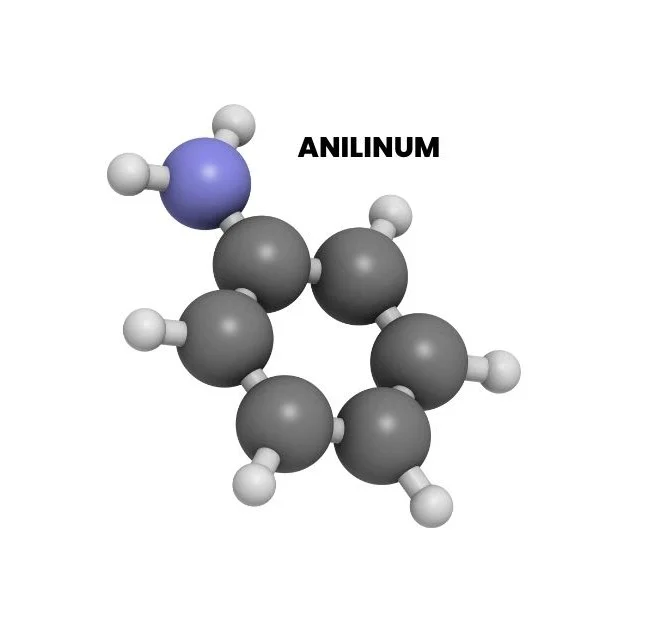Anilinum, with its intricate symptomatology, unveils a remedy profile encompassing diverse physiological systems.
The distinctive purple hue, giddiness, and genital afflictions contribute to the unique portrait of Anilinum, offering valuable insights for practitioners navigating the complexities of homeopathic prescribing.

Table of Contents
ToggleSOURCE INFORMATION
- Amidobenzene, a coal tar product.
- Amidobenzene, commonly known as Aniline, is an organic compound derived from coal tar.
- It is a clear to slightly yellow liquid with a distinctive, somewhat unpleasant odor.
- Aniline is a fundamental building block in the synthesis of various chemicals and materials.
Key Features
Chemical Structure: Aniline has a benzene ring with an amino (NH2) group attached. Its chemical formula is C6H5NH2.
Color and Odor: It is typically colorless but can turn slightly yellow upon exposure to air. Aniline has a characteristic aromatic odor.
Solubility: Aniline is miscible with most organic solvents but has limited solubility in water.
Uses
Dye Production: Aniline is a crucial precursor in the synthesis of numerous dyes, including synthetic indigo.
Rubber Processing: It is employed in the production of rubber chemicals.
Pharmaceuticals: Aniline derivatives are used in the pharmaceutical industry for manufacturing various drugs.
Polyurethane Production: Aniline is a key component in the production of polyurethane and other polymers.
Herbicides: Some herbicides are derived from aniline compounds.
KEY SYMPTOMS AND CHARACTERISTICS
- Marked Giddiness and Head Pain
- Prominent symptoms include pronounced dizziness accompanied by head pain.
- Individuals may experience a sensation of spinning.
- Purple Hue in the Face
- The face exhibits a distinctive purple hue, suggesting potential circulatory or oxygenation issues.
- This discoloration is a notable characteristic.
- Genital Afflictions
- Pain manifests in the penis and scrotum, coupled with swelling.
- These symptoms indicate potential issues in the genitourinary system.
- Urinary Passage Tumours
- Anilinum is associated with the development of tumours in the urinary passages, pointing to potential growths affecting these structures.
- Profound Anæmia
- Individuals may experience profound anemia, characterized by a significant reduction in red blood cells.
- This condition contributes to various associated symptoms.
- Discoloration of Skin
- Anilinum induces discoloration of the skin, leading to a characteristic change in the skin tone.
- This can include a bluish tint.
- Blue Lips
- Lips take on a bluish coloration, indicating potential issues with oxygenation or cardiovascular function.
- Anorexia and Gastric Disturbances
- Profound loss of appetite (anorexia) is a notable symptom, accompanied by disturbances in the gastric system.
- Gastrointestinal issues may contribute to overall debilitation.
- Swelling of Skin
- Generalized swelling of the skin is observed, potentially related to fluid retention or circulatory disturbances.
RELATIONSHIPS
- Compare with Arsenic
- Similarities in symptoms or effects on the body may be observed.
- Anilinum shares certain characteristics with Arsenic.
- Compare with Antipyrin
- Anilinum is also compared to Antipyrin, another substance with potential similarities.
- Understanding their relationships aids in distinguishing their unique applications.
POTENCY
- Generally available in the sixth potency.
FREQUENTLY ASKED QUESTIONS
What is the primary symptom related to giddiness in individuals taking Anilinum?
- Anilinum is characterized by marked giddiness, where individuals may experience a sensation of spinning or dizziness.
What notable color changes can occur in the face with Anilinum?
- The face exhibits a distinctive purple hue, which is a significant characteristic associated with Anilinum.
Which bodily areas may be affected by pain and swelling in individuals taking Anilinum?
- Pain may be noted in the penis and scrotum, accompanied by swelling.
- This points to potential genital afflictions associated with Anilinum.
What is the significance of the discoloration observed in individuals with Anilinum?
- Anilinum induces discoloration of the skin, including a bluish tint.
- This can be indicative of circulatory issues or anemia.
Are there specific urinary symptoms associated with Anilinum?
- Tumors in the urinary passages are a characteristic symptom, emphasizing potential growths affecting these structures.
How does Anilinum impact the appetite and digestive system?
- Profound anæmia is accompanied by anorexia, indicating a significant loss of appetite.
- Gastric disturbances may also be present, contributing to overall debilitation.
Is there a notable connection between Anilinum and the lips?
- Lips may exhibit a bluish coloration, emphasizing potential issues with oxygenation or cardiovascular function.
